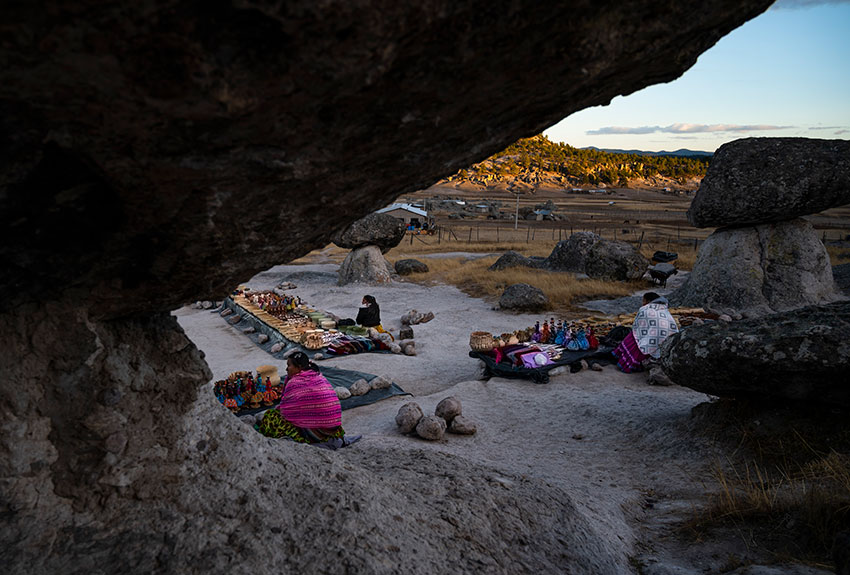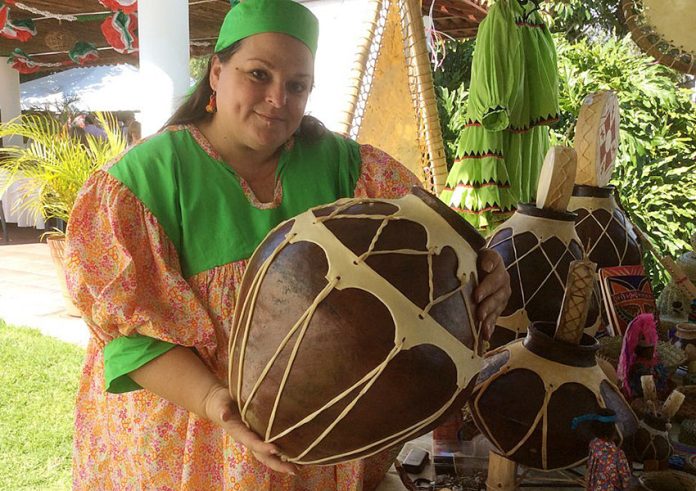Let’s be frank: Libby Townsend caught my attention because here was a white woman in full Rarámuri (Tarahumara) dress at the Feria de Maestros de Arte handcraft fair. But before anyone accuses anyone of “cultural appropriation,” it’s a good idea to know the full story.
Townsend’s story is about creating bridges of mutual respect when life presented her with the chance.
She was traveling in Chihuahua in a Jeep with friends when it broke down in the middle of nowhere and the weather was turning bad. Fortunately, a group of Rarámuri men appeared, but no one in either group spoke Spanish. With the few words they did know, plus a lot of gestures, the men promised to get help.
“Some time later, the world’s oldest logging truck appeared …” and pulled the Jeep to the next village, then from there to Creel, the center of Rarámuri country in Chihuahua. At the time there were no bank machines or cell phone reception, and the travelers were stuck in Creel as parts were located for their vehicle.
They had no money, but the townspeople gave them credit. After two weeks, parts arrived, the Jeep was fixed, and the group was able to settle their bills and be on their way.

The experience deeply impressed Townsend.
Some years later, she saw a report about a particularly bad winter in Rarámuri country. The image on her television was of two girls walking barefoot in the snow to school. The reporter asked why not stay home for a few days and the girls said they could not as one wanted to be a teacher and the other a doctor to help their people.
Townsend’s grandfather also grew up poor in the cold mountains of Montana. She decided to pay back the kindness she was shown by collecting donations of clothes and other necessities. It was slow at first, but she managed to collect enough to make the trip down to Mexico, 1,000 miles away, worthwhile.
It was supposed to be a one-time thing.
When she returned from Mexico, there were enough donations waiting for her for another trip. The problem was financing the haul. This was resolved by taking donations of items the Rarámuri did not need and holding yard sales.
These trips bloomed into The Tarahumara Project, which has moved into other activities beyond donating old clothes and blankets. It has not only benefitted the Rarámuri, but Townsend herself, giving her a mission in life, and a Rarámuri identity.

According to Townsend: “On one of the trips we were unloading blankets, etc. at the hospital … A man approached with a little girl with him and he said something. I had recognized the word for hello, so I answered him with hello. He spoke to me some more [but] all I understood was the word for gift, so I repeated it in an affirmative manner. He then took my hands in his, and put his hands on my forehead and then mine on his while talking the whole time in Rarámuri … he doesn’t speak Spanish.
“I got all tingling. It isn’t common for the traditional Tarahumara to speak to outsiders, much less a man to a woman who isn’t related. … The people who work at the hospital were dumbfounded … it turns out that he said I was good for his people, a blessing to them, good medicine. He said he would consider me to be a member of his hearth (loosely translated). The hospital staff explained that it was like making me a member of his family. I later found out that he was the head spiritual leader.”
Townsend uses traditional dress because the Rarámuri decided that she could as she is family and represents them in the outside world. This relationship has grown over decades, not only by working to get needed supplies and fair prices for Rarámuri crafts, but she is a godmother, which has great importance in Mexican and Rarámuri societies.
The world knows little of the Rarámuri, except perhaps that they can run fast in sandals. They live in some of the most inhospitable of Mexico’s environments precisely to maintain an existence that is as separate as possible. Like the Amish, the most traditional eschew things we take for granted. They will not cut down trees, or build houses, instead living under rock outcroppings blocked with stone and deadfall.
But it is not possible to be 100% self-sufficient as families need income for certain expenses, and “European” encroachment continues, today in the form of organized crime trafficking in drugs and people. Townsend and her mother have since moved to Mexico, living and working in Guadalajara as a base, but she regularly drives into the Chihuahua mountains in some of the most dangerous areas of Mexico today.
Townsend still collects donations for the communities in Chihuahua with the support of her employer, the Guadalajara Reporter. To find out how you can help, contact Libby at [email protected].
Leigh Thelmadatter arrived in Mexico 17 years ago and fell in love with the land and the culture. She publishes a blog called Creative Hands of Mexico and her first book, Mexican Cartonería: Paper, Paste and Fiesta, was published last year. Her culture blog appears weekly on Mexico News Daily.
